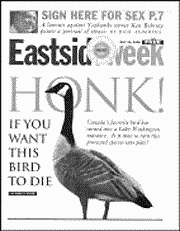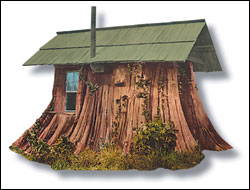CANADA GEESE have been much in the news lately, as wildlife officials prepared to adopt WTO tactics to corral and gas—albeit this time fatally—some 3,500 of these “wild,” winged annoyances this summer. Some people are upset, remembering when the geese were considered rare and precious fowl, fit for portrayal on stamps. Now many people seem to regard them as nothing less than feathered rodents, and incontinent ones at that. The average Canada goose is a veritable shit-machine, estimated to drop three pounds of crap per day. That’s one reason why Lake Washington is just about as pleasant a place to hang out as it was before Seattle stopped using the lake as a giant Porta-Potty.
I am reminded of a story Mark D. Fefer wrote a few years back when he was covering the goose menace for Eastsideweek (“Honk if you want this goose to die!” 7/24/96). Mark was the first to reveal that the Feds were considering plans to kill the geese, years before a court gave them permission to go ahead. But the most interesting thing Mark got into was how such a growing goose problem came about in the first place.
In short, it’s our fault. No, not because we’ve been overvigilant in protecting them from predators, but because greater Seattle and its suburban sprawl is designed as if by the hand of a goose-adoring demi-god.
Those little lawns and ponds in and around office parks, retirement homes, and golf courses: goose havens. Those flat, open fields of grass next to the lakes: goose Nirvana. Those big, well-watered lawns in suburban tract developments and lakeshore estates: goose Valhalla. The geese are proliferating and staying resident (as opposed to migrating) because our addiction to crabgrass is making life very, very easy for them: They can nibble away in the open air largely unmolested. Seattle may not be world-class when it hosts a trade conference like the WTO, but when it hosts fat, defecating wild birds, it’s a wet dream. Our man-made landscape is a huge open-air invitation.
Wildlife officials and angry suburbanites have faced off with animal rights activists over the necessity and ethics of a mass goose kill. But somewhere we ought to be discussing our responsibility in the whole thing: The geese are here because, as far as they’re concerned, they’ve been invited. If we want fewer geese, could we not explore other methods of development that might not be so irresistible? Could we not consider, for example, entering a 12-step program to cure us of our crabgrass habit and plant native flora in its place, plants that don’t require costly and obsessive watering and chemical maintenance?
OF COURSE, that’s too simplistic; but the goose crisis is a reminder that we live in an open-air zoo, no longer a wilderness. Everything we do impacts local wildlife, and we have to take more responsibility for the management of the local animal populations. It’s not simply a matter of hunting and fishing or not hunting and fishing, of eating or not eating meat. The animals here need to be taken care of, or they’re going to die, or at the very least be replaced by other species that thrive in proximity to humans, like the geese or rats or crows or other scavengers. Hawks, for example, love the thermals generated by highways, and the nicely trimmed roadside grass makes picking out prey a breeze.
A prime example of a species that needs our help is the region’s resident population of killer whales. Now, no one wants to gas them, because their population seems to be dwindling. Plus, like sea lions and baby seals, they seem to hold a special place in people’s hearts (remember all the controversy over shooting salmon-munching sea lions at the Ballard Locks?). But their survival does depend on decisions we make about our lifestyle, transportation, development, and whether we’ll ever clean up after ourselves. Things we do or don’t do will kill them off sure as goose gas.
According to Richard Osborne, science curator and orca researcher from the Whale Museum in Friday Harbor, the population of the southern killer whale pods that hang out in this area has declined dramatically since 1995, from 95 to 82. He believes the major factor in this decline is the high levels of toxins present in these whales, PCBs in particular. Tissue samples suggest these levels are 100 times the ones that cause reproductive failure in harbor seals, he says. Such toxin levels could be suppressing the whales’ immune system, making them more susceptible to disease.
And clearly the food supply, or lack of it, could be a factor. Earlier this year, researchers spotted local orcas frolicking and feeding all the way down in California—way off the beaten path. Despite the fact that Seattle humans gorged on Copper River salmon recently, it looks like there simply isn’t enough salmon for the orcas anymore. Perhaps freeing Willy isn’t doing him any favors—unless he can dine at McCormick & Schmick’s.
WE DO LIVE in weird wildlife times; sometimes you also get the impression that the wilderness is right on our doorstep. Last week, I saw a bald eagle feeding off Foster Island, a solo trumpeter swan cruising nearby, and, on the Arboretum on-ramp to 520, a blue heron perched on the guardrail as scores of our exhaust-spewing vehicles crawled by, apparently unfazed and uninterested in us. It would suggest wild Seattle is alive and well.
But the goose mess, the orca decline, and the salmon extinctions suggest otherwise: that we have the awkward responsibility of maintaining the environmental health of this place, yet we have little clue as to what to do, or little will to do it.







